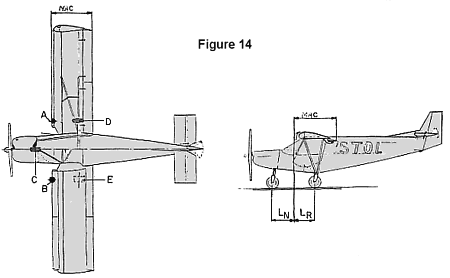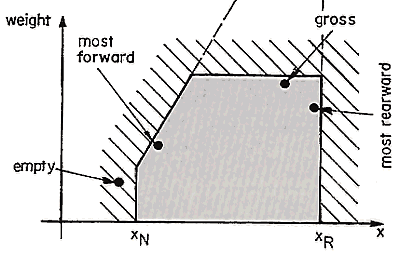By Chris Heintz, P. Eng.
[This article is part of a series, where aeronautical engineer Chris Heintz discusses light aircraft design and construction.]
Determining the weight and balance of an aircraft requires weighing the aircraft in order to find its weight and the position of its center of gravity (CG). There are several configurations to be checked: empty, most forward CG (use your common sense to find which configuration positions the most weight forward), most rearward CG (again, use your common sense to find which configuration positions the most weight rearward) and gross weight (the maximum weight at which the aircraft may fly).
- For each of the above configurations the aircraft must be leveled - a standard 16 to 18 inch spirit level must show the horizontal reference (stated by a serious designer on the drawings) to be horizontal (use small pieces of 2 x 4 and 1/2 inch plywood under the wheels until this is achieved).
- On a reasonably level floor, mark the points (A through E) where the plumb line touches. Points A and B are the right and left wing leading edge positions (close to the main wheels unless otherwise specified by the designer). Points C, D and E are the nose (tail) wheel axle and right and left main wheel axle positions respectively. See Figure 14.
After moving the aircraft away, you obtain the following information:
Draw lines AB and DE (see Figure 15) and measure the distance of lines LN and LR (this method will provide a geometric average). Note: If the shock absorbers of your aircraft are very soft you may have to measure at the various configurations and use the average LR and LN.- Next, check the accuracy of your scales: For example, your own weight should indicate the same reading on all three scales, or if you pile the scales one on top of the other, the reading should increase by the weight of the scales sitting on top of the one you are reading. Note: In most cases three bathroom scales are adequate, provided you've checked them for accuracy - your better half, daughters) or neighbors may not be aware of the care required to maintain "precision" scales.

 To check if your
aircraft is within the limits given by the designer, mark the following points on the
weight and balance diagram.
To check if your
aircraft is within the limits given by the designer, mark the following points on the
weight and balance diagram.
